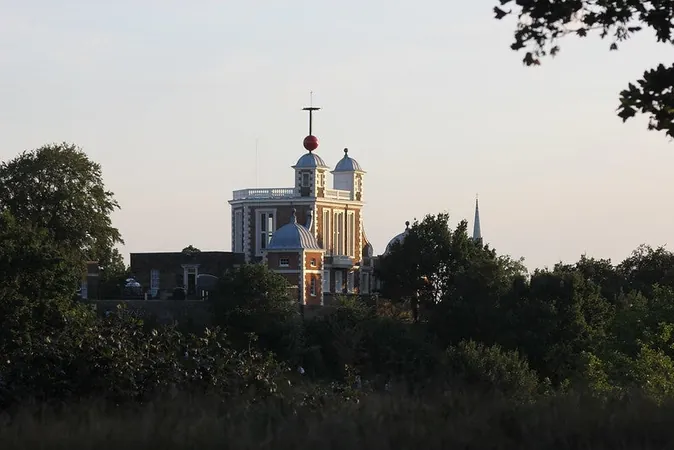
Astronomers Royal: 350 Years of Stellar Guidance to British Monarchs
2025-06-09
Author: Wei
A Legacy Written in the Stars
Hidden near the Moon’s western limb lies the Oceanus Procellarum, or the Ocean of Storms—an expansive region that stretches 1,600 miles (2,500 kilometers) and covers over 10% of the lunar surface. Among its many craters is Flamsteed, named after Britain’s inaugural Astronomer Royal, John Flamsteed. This ancient 13-mile-wide crater stands as a testament to a legacy that has helped shape our understanding of the cosmos.
The Origin of Astronomers Royal
For 350 years, a series of Astronomers Royal have served as celestial advisors to British monarchs, guiding them on myriad issues—ranging from navigation and timekeeping to the complexities of climate change and robotics. Among them, nine were knighted for their invaluable contributions, with the current title holder, Professor Sir Martin Rees, holding a lifelong peerage within Britain’s House of Lords.
John Flamsteed: The Pioneer
Originating from Derbyshire, John Flamsteed’s early years were steeped in arithmetic, fractions, and the scientific knowledge of his time. His fascination with astronomy ignited after witnessing a partial solar eclipse, leading him to author his first scientific paper at just 19. His path to success was paved by a wealthy patron, Sir Jonas Moore, who advocated for a London observatory.
Flamsteed’s appointment as the "King’s Astronomical Observator" in 1675 opened doors to unprecedented exploration. Despite initially dismissing a Moon-based method for determining longitude, Flamsteed’s role would help lay the groundwork for the Royal Greenwich Observatory.
A Legacy of Precision
Though he never officially bore the title "Astronomer Royal" during his lifetime, Flamsteed set high standards of accuracy, leaving behind a detailed catalog of stars and celestial movements. His fierce dedication led him into conflict with Sir Isaac Newton over the Royal Society’s scrutiny of his work. Flamsteed’s posthumous accolades came largely thanks to his wife, Margaret, who published much of his work, aiding in the elevation of both Flamsteed’s and Greenwich’s renown in astronomical research.
Contributions Over Centuries
From Flamsteed to Edmond Halley and beyond, the first six Astronomers Royal tirelessly worked to tackle the longitude issue. Halley, in 1731, proved longitude could indeed be measured using lunar motions. The succeeding astronomers continued to build upon this foundation, leading to incredible breakthroughs such as the measurement of light speed and the establishment of the Nautical Almanac.
By the 19th century, Greenwich had become synonymous with timekeeping, including the introduction of the iconic time-ball by John Pond to help synchronize clocks across the maritime world.
Tales of Triumph and Blunders
However, the journey wasn't without stumbling blocks. Astronomer Royal George Biddell Airy faced backlash for his failure to act upon a prediction concerning Neptune's location, costing Britain a significant discovery. His counsel regarding the construction of a bridge that tragically collapsed was another instance where his reputation suffered.
Even in the Space Age, skepticism lingered among astronomers about the feasibility of human space travel. Harold Spencer Jones famously doubted a manned Moon landing could ever happen, evoking laughter from future generations.
Quantum Leaps into the Future
From necessities of navigation to complex scientific advancements, the role of the Astronomer Royal has evolved remarkably over 350 years. Today, with the ever-pressing challenges of our time, Professor Sir Martin Rees underscores the power of astronomy to bridge national and cultural divides, revealing profound truths about the universe and ourselves.




 Brasil (PT)
Brasil (PT)
 Canada (EN)
Canada (EN)
 Chile (ES)
Chile (ES)
 Česko (CS)
Česko (CS)
 대한민국 (KO)
대한민국 (KO)
 España (ES)
España (ES)
 France (FR)
France (FR)
 Hong Kong (EN)
Hong Kong (EN)
 Italia (IT)
Italia (IT)
 日本 (JA)
日本 (JA)
 Magyarország (HU)
Magyarország (HU)
 Norge (NO)
Norge (NO)
 Polska (PL)
Polska (PL)
 Schweiz (DE)
Schweiz (DE)
 Singapore (EN)
Singapore (EN)
 Sverige (SV)
Sverige (SV)
 Suomi (FI)
Suomi (FI)
 Türkiye (TR)
Türkiye (TR)
 الإمارات العربية المتحدة (AR)
الإمارات العربية المتحدة (AR)